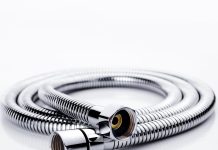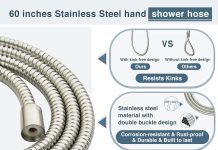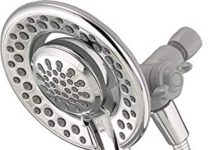There comes a time in every homeowner’s life when they must confront the age-old question: when should I replace an aging shower hose? We’ve all been there, standing beneath the warm cascade of water, wondering if it’s time to bid farewell to our trusty companion. In this article, we will explore the telling signs that indicate it’s time for a new shower hose, ensuring you never miss a beat in your quest for the perfect shower experience. So, grab your loofah, and let’s embark on this enlightening journey together.
Table of Contents
Signs of an aging shower hose
Visible wear and tear
One of the first signs that your shower hose is aging is visible wear and tear. Over time, the constant exposure to water and moisture can cause the hose to deteriorate. You may notice cracks, splits, or even holes in the hose. Additionally, the color of the hose may fade, and the texture may become rough or brittle.
Leaks and drips
Another clear indication that your shower hose is showing its age is the presence of leaks and drips. If you start noticing water pooling around the hose connection or a steady drip even when the shower is turned off, it’s likely a sign that the hose is no longer functioning properly. These leaks can waste water and increase your utility bills, so it’s important to address them promptly.
Loss of flexibility
As a shower hose gets older, it may lose its flexibility. This can make it more difficult to maneuver and adjust the showerhead, affecting your overall showering experience. If you find that it’s becoming increasingly challenging to move the showerhead to different angles or positions, it may be time to replace the hose.
Discoloration or rust
Discoloration or rust on the surface of the shower hose can also indicate that it is aging. Over time, minerals and rust from the water can build up on the hose, causing discoloration and potentially compromising its structural integrity. This can not only affect the appearance of your shower hose but also impact its functionality.
Lack of water pressure
If you begin to experience a significant decrease in water pressure while using your shower, it could be a sign of an aging shower hose. As the hose wears out, it may become clogged with debris or mineral deposits, restricting the flow of water. Low water pressure can be frustrating and make it difficult to rinse off properly during showers.
Safety concerns
Risk of bursting
One of the major safety concerns associated with an aging shower hose is the risk of bursting. As the hose deteriorates, it becomes more prone to breaking under pressure. A burst shower hose can result in a sudden release of water, potentially causing damage to your bathroom and posing a slip hazard. Additionally, the force of the water can lead to personal injury.
Potential for scalding
Another safety risk of an aging shower hose is the potential for scalding. Over time, the hose may develop leaks or cracks, which can lead to fluctuations in water temperature. These sudden changes can result in hot water scalds, especially if the water becomes excessively hot without warning. Protecting yourself and your family from potential burns is crucial, and replacing an aging shower hose can help prevent these accidents.
Mold and mildew growth
An aging shower hose that is leaking or has cracks can create an environment for mold and mildew growth. The damp conditions, combined with the constant presence of water, promote the growth of these harmful substances. Not only can mold and mildew impact the air quality in your bathroom, but they can also cause health problems, especially for those with respiratory issues or allergies.
Impact on water quality
Mineral buildup
As a shower hose ages, it becomes more susceptible to mineral buildup. Over time, minerals present in the water can accumulate inside the hose, restricting the flow and affecting water quality. Mineral buildup can lead to a decrease in water pressure and may even cause blockages in the hose. This can impact your overall showering experience and make it more difficult to rinse off properly.
Reduced hygiene
An aging shower hose can compromise hygiene due to the presence of mold, mildew, and bacteria. The damp and dark environment inside the hose can provide a breeding ground for these microorganisms. When you shower, these contaminants can be released onto your body and hair, potentially leading to skin irritations, infections, and other health issues.
Unpleasant odors or tastes
If you notice unpleasant odors or tastes coming from your shower water, it could be a result of an aging shower hose. As the hose deteriorates, it can absorb odors and tastes from the water passing through it. These unpleasant smells or flavors can be off-putting and make your showering experience less enjoyable. Replacing the hose can help eliminate these issues and ensure fresh, clean water.
Comfort and convenience
Difficulty adjusting temperature
An aging shower hose can make it difficult to adjust the water temperature to your liking. Over time, the hose may develop leaks or cracks, causing fluctuations in water temperature. This can be particularly frustrating when you’re trying to achieve the perfect balance between hot and cold water. With a new, properly functioning shower hose, you can effortlessly achieve your desired temperature.
Inadequate water flow
As a shower hose ages, it may become clogged with debris or mineral buildup, resulting in inadequate water flow. If you notice a decrease in the amount of water coming out of your showerhead, it could be a sign that your hose needs replacing. Having a strong and steady water flow can significantly enhance your showering experience and allow for efficient rinsing.
Worn-out connections
Over time, the connections on an aging shower hose may start to wear out. This can lead to water leaks and drips, affecting both water pressure and the integrity of the hose. If you find that the hose connection is loose or frequently comes undone, it’s a clear indication that replacement is necessary. A new hose will provide secure connections and prevent any water loss.
Frequency of replacement
Manufacturer recommendations
When it comes to replacing an aging shower hose, it’s important to check the manufacturer’s recommendations. Different manufacturers may provide guidelines on the expected lifespan of their hoses and when replacement is recommended. Following these recommendations can help you avoid potential safety issues and ensure the longevity of your shower hose.
Typical lifespan
The typical lifespan of a shower hose can vary depending on factors such as usage, water quality, and maintenance. On average, a well-maintained shower hose should last around 5 to 10 years. However, if you live in an area with hard water or if the hose experiences heavy use, it may wear out more quickly. Regular inspections and proper maintenance can help prolong the lifespan of your shower hose.
Quality of materials
The quality of materials used in the construction of a shower hose can greatly impact its lifespan. Opting for a higher-quality hose made from durable materials can result in a longer-lasting product. While these hoses may be more expensive initially, they often offer superior performance and can save you money in the long run by reducing the need for frequent replacements.
Water hardness levels
The hardness of your water can also affect the lifespan of your shower hose. Hard water contains high levels of minerals, such as calcium and magnesium, which can contribute to mineral buildup and deterioration of the hose over time. If you live in an area with hard water, consider using a water softener or installing a filter to help protect your shower hose and prolong its lifespan.
DIY inspection and maintenance
Regular visual inspection
Performing regular visual inspections of your shower hose is an essential part of maintenance. Look for any signs of wear and tear, such as cracks, splits, or discoloration. Pay close attention to the hose connections as well, as leaks often occur in these areas. By identifying any issues early on, you can take prompt action to prevent further damage or potential safety hazards.
Checking for leaks
To ensure your shower hose is in good condition, it’s essential to check for leaks. Turn on the shower and carefully inspect the hose and connections for any signs of water leakage. If you notice even a small drip, it’s an indication that the hose needs attention. Tightening loose connections and replacing worn-out washers or seals can often solve minor leaks. However, if the leaks persist, it may be time for a replacement.
Cleaning and descaling
Regularly cleaning and descaling your shower hose can help maintain its performance and prolong its lifespan. Use a mild cleaning solution or vinegar to remove mineral deposits and any build-up that may be obstructing water flow. Scrub the hose gently with a soft brush to avoid damaging the surface. Rinse thoroughly to remove any residue before reattaching to the showerhead.
Replacing washers and seals
If you notice leaks at the hose connections, it’s likely due to worn-out washers or seals. These small components are responsible for creating a watertight seal and preventing leaks. Regularly check and replace any damaged or deteriorating washers or seals to ensure proper function. This simple maintenance task can save you from potential water wastage and the need for a complete hose replacement.
When repairs are not enough
Persistent leaks or drips
While minor leaks can often be fixed with simple repairs, persistent leaks or drips may indicate more serious hose damage. If you’ve tried tightening connections, replacing washers, and the leaks continue, it’s a strong indication that the hose is beyond repair. Continuing to use a hose with persistent leaks can lead to further damage or safety hazards, so it’s best to replace it.
Bulging or frayed hose
If you notice any bulging or fraying along the length of your shower hose, it’s a clear indication that a replacement is necessary. These signs of physical damage typically occur due to the deterioration of the hose material. Using a hose in this condition poses a significant safety risk, as it may burst under pressure and cause water damage or personal injury.
Testing water pressure
If you suspect that your aging shower hose is impacting water pressure, you can perform a simple test to confirm. Turn on the shower and assess the strength and consistency of the water flow. If you notice a significant decrease or fluctuations in water pressure, it’s likely that the hose is obstructed or damaged. Consider replacing the hose to restore optimal water flow.
Consistent poor water quality
An aging shower hose can contribute to consistently poor water quality. If you continue to experience issues such as unpleasant odors, tastes, or mineral buildup, despite regular cleaning and maintenance, it may be time for a replacement. By ensuring a new, clean hose, you can enjoy fresh and hygienic water during your showers.
Replacing the shower hose
Choosing the right replacement hose
When it’s time to replace your aging shower hose, it’s important to choose the right replacement. Consider factors such as length, flexibility, and material. Measure the length of your current hose to ensure you select a replacement that will fit your shower setup. Opting for a flexible hose made from durable materials, such as stainless steel or reinforced plastic, can ensure longevity and optimal functionality.
Gathering necessary tools
Before beginning the replacement process, gather the necessary tools for the job. You may need an adjustable wrench, pliers, Teflon tape, and a cleaning cloth. Ensure you have all the tools within reach to make the installation process smoother and more efficient.
Shutting off the water supply
To avoid any potential water damage or accidents, it’s crucial to shut off the water supply before replacing the shower hose. Locate the water shut-off valve, usually located near the shower or in the basement, and turn it off. This step will prevent water from flowing through the hose during the installation process.
Removing the old hose
To remove the old shower hose, start by loosening the connections with an adjustable wrench or pliers. Unscrew the hose from both the showerhead and the water supply pipe. Be careful not to force or twist too hard, as this could damage the connections or other components. Once the hose is free, inspect the connections for any signs of damage and clean the area thoroughly.
Installing the new hose
With the old hose removed, it’s time to install the new one. Begin by wrapping Teflon tape around the threads of both the showerhead and water supply pipe. This will create a secure and watertight seal. Screw the new hose onto the showerhead connection, ensuring it is tightened securely. Then, attach the other end of the hose to the water supply pipe connection in the same manner. Take care not to overtighten, as this can cause damage.
Testing for leaks
Once the new shower hose is securely installed, it’s important to test for leaks. Turn on the water supply and inspect the connections for any signs of water leakage. If you notice any leaks, try tightening the connections further or applying additional Teflon tape. If the leaks persist, you may need to seek professional help or consider replacing the connections.
Professional installation
When to seek professional help
While replacing a shower hose can often be a DIY project, there are instances where it may be necessary to seek professional help. If you’re uncomfortable performing the replacement yourself or if you encounter any difficulties during the process, it’s best to consult a qualified plumber. Additionally, if you have any concerns about the integrity of your plumbing system or if you suspect other underlying issues, professional assistance is recommended.
Finding a qualified plumber
When searching for a qualified plumber to assist with the installation, consider asking friends or family for recommendations. Check online reviews and ratings for local plumbers to ensure they have a good reputation and reliable service. It’s also important to verify that the plumber you choose is licensed and insured to protect yourself from any potential liability.
Cost considerations
The cost of professional installation can vary depending on factors such as location, complexity of the job, and the plumber’s rates. It’s advisable to contact multiple plumbers and request quotes for comparison. While it may incur additional expenses, professional installation can provide peace of mind knowing the job is done safely and correctly.
Conclusion
Recognizing the signs of an aging shower hose is crucial to ensuring safety, maintaining water quality, and enjoying a comfortable showering experience. Visible wear and tear, leaks, loss of flexibility, discoloration or rust, and lack of water pressure are all indicators that it may be time to replace your shower hose. Neglecting an aging hose can lead to safety concerns like bursting or scalding, as well as mold and mildew growth. The impact on water quality includes mineral buildup, reduced hygiene, and unpleasant odors or tastes. Additionally, an aging hose can compromise comfort and convenience due to difficulty adjusting temperature, inadequate water flow, and worn-out connections.
The frequency of replacement depends on manufacturer recommendations, typical lifespan, quality of materials, and water hardness levels. Conducting regular DIY inspections and maintenance, such as visual inspections, checking for leaks, cleaning, descaling, and replacing washers and seals, can help prolong the lifespan of your shower hose. However, when repairs are not enough and issues such as persistent leaks, bulging or frayed hoses, poor water pressure, and consistent poor water quality arise, it’s time to consider replacing the shower hose.
Replacing the shower hose involves choosing the right replacement, gathering necessary tools, shutting off the water supply, removing the old hose, installing the new hose, and testing for leaks. In some cases, it may be necessary to seek professional installation, especially if you are uncomfortable with DIY or encounter complications during the process. When seeking professional help, ensure you find a qualified plumber with a good reputation and consider the cost implications.
In conclusion, timely replacement of an aging shower hose is crucial for ensuring safety, maintaining water quality, and enjoying a comfortable shower experience. By recognizing the signs of an aging hose, performing regular inspections and maintenance, and taking prompt action when repairs are not sufficient, you can keep your showering routine hassle-free and enjoyable.






















